|
December 1, 1997, with subsequent revisions
There has been much discussion in the media lately about the Bureau of Land Management's (BLM's) "Adopt- a- Horse" program. News reports have spoken of adopted horses ending up at the slaughterhouse or becoming "missing" after adoption. Some reporters have questioned if the are better off being adopted rather than left to fend for themselves in the "wild". Horses are not native to North America. As a reintroduced species, they have settled in numerous regions of the United States and in many of these regions there is fierce competition for available resources. Adult horses don't have significant natural predators, therefore there are only two limiting factors to their population, starvation as they outstrip the land's food supply (which also adversely affects other grazing wildlife), or human intervention. Particularly during times of drought, life can be extremely hard on the horse herds in the poorer areas and many die. Subsequent to an Act of Congress, BLM has established numerous Herd Management Areas (HMAs) and BLM naturalists have estimated the populations that each HMA can adequately support. The concept here is to remove "excess" numbers of horses, place them in adoptive care, and in doing so give the "wild" herds, other native plant eating animals and the range itself, chances to remain vital and healthy. Please note: There are varying positions as to how many horses constitute viable herds and appropriate populations on specific ranges. It is not the intent of this particular document to evaluate that debate. Regarding the slaughterhouse issue, federal regulations are very clear. Horses, burros and mules may only be adopted for personal use, not for commercial purposes or profit. It is illegal to adopt a horse and then sell it for slaughter. Many of these protections were repealed in December 2004. Please see 2005 Update, below. Unfortunately, horses from all walks of life are going to find their way to the slaughterhouse. With the present shortage of beef in Europe due to the "mad cow disease" there is high demand for horse meat. Some will argue that using horses for food is as logical as using cattle, however the fact remains that it is illegal to sell off BLM horses for slaughter and the practice needs to be stopped. The BLM certainly doesn't condone the sending of adopted animals to slaughter. The Adopt-a- Horse program, however, relies a great deal on volunteers in order to ensure the welfare and proper use of adopted animals. (Due to the sheer volume of adoptions, it would be too costly to run the program if it relied entirely on salaried governmental personnel.)
The BLM can always use more volunteer assistance. Practical horse experience helps, however even if you are willing to just help out and learn, the volunteer program may well benefit from your participation. Contact your area field office and ask to be put in touch with their volunteer coordinator. You can do a great deal of good and enjoy your involvement with this unique program.
Back in 1992, through some unusual twists of fate, we ended up with two BLM horses and a couple of burros at KBR. While we had a ranch full of horses, from minis to drafters, we found the BLM animals very special and enjoyable to bring up. The horses were really handy mounts and the burros were just plain fun to have around. We were familiar with instinctive horse behavior and in a very short time (as in a matter of days) the BLM horses were comfortably under saddle, were going out on trail, taking obstacles, etc. To get this kind of "rapid response", we concentrated on tried and true principles of basic horse behavior (many of which we share in the Training Section on this website).
If you're not too sure of yourself, adopt a horse which has already been halter broken. These animals have had more exposure to human contact and are less reliant on their basic wariness and flight instincts. You can build on the gentling process which has already begun. Also, it often pays to develop a relationship with BLM volunteers in your area. They can be most helpful. Once you have a horse you may find it more beneficial to have him started to saddle by a professional. There are a number of people who are very successful with these animals, they travel and put on group weekend clinics, and some programs are as inexpensive as $60.00 per day. Usually the format involves "colt starting" on Saturday with horse handling, which may include riding, the next day. In some instances we've seen horses started on Saturday and their owners riding them on Sunday; walking, trotting and taking obstacles in a group class. Thus, starting your horse does not have to be expensive, and in many of these programs you can learn as much as your horse. The idea here is that, apart from the initial "saddling and mounting" of the horse, you will be involved working with your horse on a "hands on" basis. Whether you can actually ride your horse usually depends on how well adjusted the horse is, the relevance of the approaches used on a particular horse, and how skillful you are as a rider. (The horse still needs to be "finished", but you will have gotten past the toughest part.)
In summary, if you're concerned about the welfare of BLM the animals placed by BLM with adopters there are many ways you can actually do something. Whether as a volunteer or responsible adopter, you can become part of the solution rather than merely worry about the problem. This is not a BLM operated or BLM sponsored site.
It is run by private wild horse and burro enthusiasts.
1998 Update: Since I originally posted this opinion, more Federal cutbacks are occurring as Washington grapples with reducing the national debt. From what I have read, the BLM has been significantly impacted as a result. Thus if programs such "Adopt a Wild Horse or Burro" are going to succeed, it's going to take more "citizen volunteer" involvement than ever. So, if you are interested in helping, contact your local BLM office and find out what's happening in your area.
2000 Update: Through collective efforts of wild horse and burro advocacy groups and tens of thousands of American citizens, Congress has temporarily increased BLM's funding in order to enable BLM to improve its wild horse and burro programs. Much of this effort will involve cooperation between BLM and various wild horse and burro groups. Do you want to help wild horses and burros? Affiliate with one of the wild horse and burro groups and lend a hand.
2005 Update: Just before the Thanksgiving recess, Senator Conrad Burns (R-MT) secretly inserted a rider in the 2005 appropriations bill that repealed major portions of the Wild-Free Roaming Horses and Burros Act. While this was clearly undemocratic and an abuse of the rider process (repealing a 33 year old Federal law without a public hearing) President Bush signed the onmibus spending bill into law. Ergo all horses and burros ten years of age or older, and all horses offered three times and not adopted are ordered to be disposed of by any means. Wild horse advocates fear that the killer buyers are the only ones with deep enough pockets to absorb over 8,000 horses. For a story on this legislation, please
click here.
The nation's wild horse and humane groups have formed an alliance to address the Burns rider. The following links can provide information on this effort.
January '05 Wild Horse Emergency ConferenceAlliance of Wild Horse Advocates (web site)
Return to Wild Horse Issues and AnswersReturn to Wild Horse & Burro News PageReturn to KBR World of Wild Horses & BurrosGo to KBR Training SectionGo to other Wild Horse LinksGo To
|
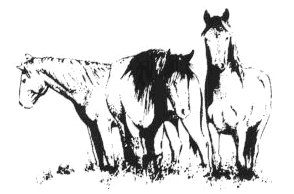
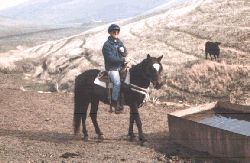 Another
problem involves adopters who bring home a wild horse or burro on a lark or
due to the mystique of taming a "wild" animal, and they are not prepared
for the work and patience which goes into successful gentling. Again, the
volunteers play an extremely important role in providing a support
structure to assist inexperienced adopters and guide them through the rough spots. Adopters need to more fully utilize this resource.
Another
problem involves adopters who bring home a wild horse or burro on a lark or
due to the mystique of taming a "wild" animal, and they are not prepared
for the work and patience which goes into successful gentling. Again, the
volunteers play an extremely important role in providing a support
structure to assist inexperienced adopters and guide them through the rough spots. Adopters need to more fully utilize this resource.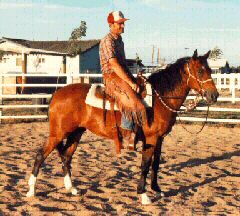 You can
also benefit the program and its animals by adopt the right attitude and approach if you
decide to adopt.
You can
also benefit the program and its animals by adopt the right attitude and approach if you
decide to adopt.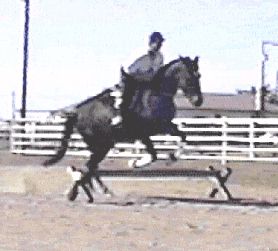 Those of you
out there who are not as well versed in the subtleties of horse
communication and social behavior can be equally successful. A little
patience and following the advice of those who are used to handling these
animals can bring you success, plus you will gain a great deal of
knowledge along the way which can be carried over to the handling of your
domestic horses.
Those of you
out there who are not as well versed in the subtleties of horse
communication and social behavior can be equally successful. A little
patience and following the advice of those who are used to handling these
animals can bring you success, plus you will gain a great deal of
knowledge along the way which can be carried over to the handling of your
domestic horses.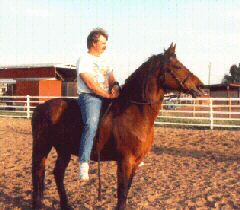 There is a great deal of good information available.
Barbara Eustis-Cross and Nancy Bowker prepared an excellent book on the
subject. Some details appear on this website in
There is a great deal of good information available.
Barbara Eustis-Cross and Nancy Bowker prepared an excellent book on the
subject. Some details appear on this website in 